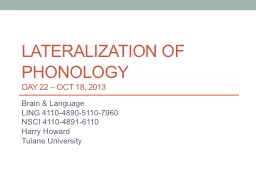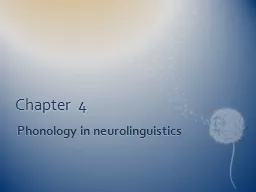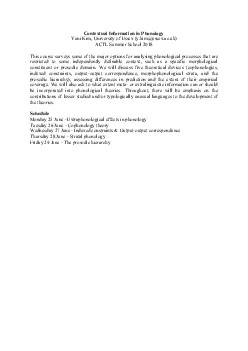PPT-Phonology
Author : debby-jeon | Published Date : 2015-11-27
Phonemes the smallest sound unit in a particular language that can indicate a difference in meaning Lets take an example from English and another from Arabic In
Presentation Embed Code
Download Presentation
Download Presentation The PPT/PDF document "Phonology" is the property of its rightful owner. Permission is granted to download and print the materials on this website for personal, non-commercial use only, and to display it on your personal computer provided you do not modify the materials and that you retain all copyright notices contained in the materials. By downloading content from our website, you accept the terms of this agreement.
Phonology: Transcript
Phonemes the smallest sound unit in a particular language that can indicate a difference in meaning Lets take an example from English and another from Arabic In English t is considered a phoneme because the change of this sound in the word . I am indebted to Larry Hyman, Mathias Jenny, Michael Kenstowicz, Darlene LaCharit - Dealing with Hotspots Richard Cauldwell www.speechinaction.com www.spee china ction.com Phonology for Listening e Section A – A Window on speech e Section B – The nature of spontaneo DAY 7 CESAR KOIRALA Ling 403/603 Consonant ( Place ) features The following features tell us about the active articulator involved ( Major articulator features ). 1. [+labial] =articulated with li Zo Katie Burns. Title III Resource Teacher. Introductions. . Phonetics vs. Phonology. Turn and talk. . . Phonetics vs. Phonology. . Turn and talk sentence starter:. Phonetics and Phonology both __________.. Manal. A. . Allehyani. Phonetics Vs. Phonology. Whereas syntax is about sentence formation, and semantics about sentence interpretation, phonetics and phonology cover the field of sentence utterance. . DAY 22 – Oct 18, 2013. Brain & Language. LING 4110-4890-5110-7960. NSCI 4110-4891-6110. Harry Howard. Tulane University. Course organization. The syllabus, these slides and my recordings are available at . John J. Ohala University of California, Berkeley, USA Phonetics attempts to describe and understand how speech is produced and perceived; phonology attempts to understand the patterning—in gene . . . Vowels: Diphthongs . . . Talib M. Sharif Omer. Assistant lecturer . . Email: . Talib.omer@soran.edu.iq. October 29, 2015. 1. Quiz -A . A: Find . out the phonetic symbol for the first sound in each of the following words:. By. Group Captain. MUHAMMAD AKRAM MANKASH ®. WHAT IS LISTENING?. Generally listening is understood as . hearing. . . BUT LISTENING. …. i. s. . following and understanding the sound. s / monitoring gestures as in involves perception,…. impairment. in . French-speaking children with SLI. Christophe Parisse. 1 . and Christelle Maillart. 2. . 1. MoDyCo, INSERM, CNRS-Paris . Ouest. . Nanterre. (France). 2. University of . Liège. (Belgium). of. English inflectional morphology. Themis Karaminis, 09-May-2008. Overview. Connectionist models of morphology. Rumelhart. & McClelland (1986). Plunkett & . Marchman. (1991,1993) . Phonetics. Both study speech sounds.. Phonetics focuses on sound aspects in terms of their . Articulatory movement. Distinctive features. Acoustic features. Perceptual properties. Example: the sounds of English and Spanish. Notice that even in classic Optimality Theory operations are performed on URs This is the job of GEN So for a mapping A 3 GEN candidates EVAL constraint ranking A -What principles if any constrain t
Download Document
Here is the link to download the presentation.
"Phonology"The content belongs to its owner. You may download and print it for personal use, without modification, and keep all copyright notices. By downloading, you agree to these terms.
Related Documents














